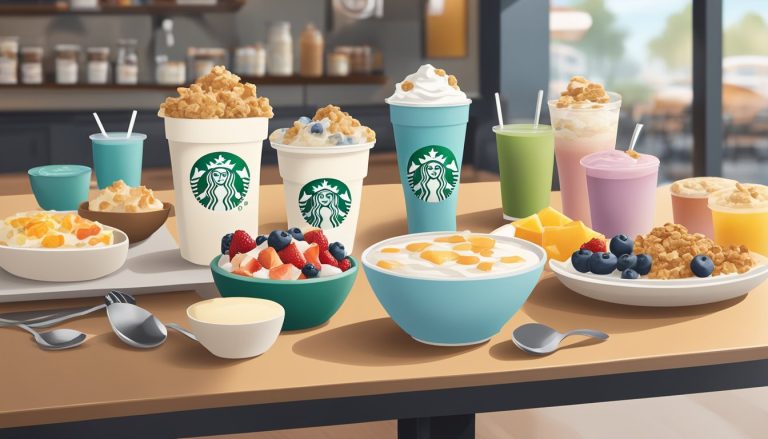Starbucks has revolutionized its menu offerings with the introduction of protein boxes. These convenient, grab-and-go options cater to health-conscious customers seeking balanced meals on the move. Protein boxes typically contain a mix of foods like eggs, cheese, fruits, vegetables, and spreads, providing a well-rounded nutritional profile.
Starbucks protein boxes offer at least 20 grams of protein per serving, along with a minimum of one cup of combined fruits and vegetables. This focus on protein content aligns with growing consumer demand for nutrient-dense, satisfying meal options that support active lifestyles. The variety of protein boxes available ensures customers can find choices that suit their dietary preferences and taste preferences.
The rise of protein boxes at Starbucks reflects a broader trend in the food and beverage industry towards healthier, more balanced meal options. By expanding beyond traditional coffee shop fare, Starbucks has positioned itself to meet evolving consumer needs and preferences in the quick-service sector. The success of these protein-packed offerings may inspire further innovations in Starbucks’ menu and influence competitors in the market.
The Concept of Protein Boxes at Starbucks

Starbucks introduced protein boxes as a convenient, nutritious meal option for customers on the go. These curated selections combine protein-rich foods with fruits, vegetables, and grains to create balanced, portable meals.
Historical Development
Starbucks launched protein boxes in response to growing consumer demand for healthier, more substantial food options. The company recognized that many customers sought quick meals that could fuel their busy lifestyles without compromising on nutrition.
Initially, Starbucks offered a limited selection of protein boxes. These early versions focused on classic combinations like cheese and fruit. As popularity grew, the company expanded its range to include more diverse options.
Protein boxes quickly became a hit among health-conscious customers and those looking for convenient lunch alternatives. The success of these offerings prompted Starbucks to invest further in their development and marketing.
Strategic Expansion
Starbucks strategically expanded its protein box lineup to cater to various dietary preferences and nutritional needs. The company introduced options with at least 20 grams of protein per box, ensuring customers received a substantial energy boost.
New additions to the menu included vegetarian and vegan-friendly choices. Starbucks also incorporated more whole grains and increased the variety of fruits and vegetables in their boxes.
The company focused on improving the overall nutritional profile of protein boxes. Many options now contain less than 500 calories and provide a good balance of macronutrients. This approach aligns with Starbucks’ commitment to offering healthier food choices alongside their signature beverages.
Nutritional Breakdown

Starbucks protein boxes offer a balanced mix of nutrients to fuel customers throughout the day. These convenient options provide a variety of macronutrients and essential components for a well-rounded meal or snack.
Protein Content and Sources
Protein boxes at Starbucks typically contain 20-30 grams of protein per serving. This substantial amount helps support muscle maintenance and promotes satiety. Common protein sources include:
- Hard-boiled eggs
- Cheese (cheddar, gouda)
- Peanut butter
These options cater to different dietary preferences and provide high-quality protein. The combination of animal and plant-based proteins ensures a diverse amino acid profile.
Balancing Carbohydrates and Healthy Fats
Starbucks protein boxes incorporate a mix of carbohydrates and healthy fats to complement the protein content. Carbohydrate sources often include:
- Fresh fruits (apples, grapes)
- Whole grain bread or crackers
Healthy fats come from:
- Nuts (almonds, cashews)
- Cheese
- Peanut butter
This balance helps stabilize blood sugar levels and provides sustained energy. The combination of macronutrients promotes fullness and satisfaction.
Benefits of Dietary Fiber
Dietary fiber is an essential component of Starbucks protein boxes. Sources include:
- Fresh fruits
- Vegetables (carrots, celery)
- Whole grain products
Fiber aids digestion, promotes gut health, and contributes to feelings of fullness. Most protein boxes contain 3-5 grams of fiber, supporting daily intake recommendations.
The inclusion of fiber-rich foods helps balance the protein and fat content, creating a more nutritionally complete meal option. This combination of nutrients supports overall health and wellness for Starbucks customers.
Diverse Offerings

Starbucks offers a variety of protein boxes to cater to different dietary needs and preferences. These options include cheese selections, plant-based choices, and allergy-friendly alternatives.
Overview of Different Protein Boxes
Starbucks introduced protein boxes in summer 2017 to expand its food offerings. The range includes options like the Cheese Trio Protein Box, which features a selection of cheeses paired with fruit and crackers. Plant-based alternatives are also available, such as the PB & Trail Mix Snack Box.
Some protein boxes incorporate whole grains like muesli bread and quinoa, adding nutritional value and texture. These boxes typically contain a mix of proteins, carbohydrates, and healthy fats to provide a balanced meal or snack.
Popular Choices and Ingredients
The Cheese Trio Protein Box is a customer favorite, offering a variety of cheeses alongside fruits and nuts. Other popular options include boxes with hard-boiled eggs, peanut butter, and various types of lean meats.
Common ingredients found in Starbucks protein boxes:
- Cheeses (cheddar, brie, gouda)
- Fresh fruits (grapes, apples)
- Nuts and seeds
- Whole grain crackers
- Hummus
- Vegetables (carrots, cucumber)
These ingredients are carefully selected to provide a nutritious and satisfying meal option for customers on the go.
Gluten-Free and Allergy-Friendly Options
Starbucks has expanded its menu to include gluten-free and allergy-friendly protein boxes. These options cater to customers with dietary restrictions or food sensitivities.
Gluten-free choices may include boxes with rice cakes instead of wheat-based crackers. For those with nut allergies, Starbucks offers boxes that are free from peanuts and tree nuts.
The company clearly labels its products to help customers make informed choices. Starbucks also provides detailed ingredient information on its website and mobile app, allowing customers to check for potential allergens before purchasing.
Health and Diet Considerations

Starbucks protein boxes offer a mix of nutrients and convenience for health-conscious consumers. These options cater to various dietary needs while providing balanced meals on-the-go.
Aligning with Dietary Guidelines
Protein boxes at Starbucks generally align with nutritional recommendations. Most contain 20-26 grams of protein, supporting muscle health and satiety. Calorie counts range from 460-560 per box, fitting within typical meal allowances.
Many boxes include fruits and vegetables, contributing to daily fiber intake. The Eggs & Gouda box, for example, offers 5 grams of fiber. This helps meet the recommended 25-30 grams per day for adults.
Fat content varies, with some options providing healthier unsaturated fats from nuts and seeds. However, cheese and meats can contribute to saturated fat intake, requiring mindful choices for those monitoring their fat consumption.
Target Demographics
Starbucks protein boxes cater to diverse dietary preferences and needs. They appeal to busy professionals seeking quick, balanced meals and health-conscious consumers looking for portion-controlled options.
Fitness enthusiasts appreciate the high protein content, which supports muscle recovery and growth. The boxes also attract those following gluten-free diets, with clearly labeled options available.
Weight-watchers find the pre-portioned meals helpful for calorie control. The lower-calorie choices, like the 470-calorie PB&J box, fit well into calorie-restricted meal plans.
Vegetarians have dedicated options, expanding the accessibility of these convenient meals. This inclusivity helps Starbucks reach a broader audience with their protein box offerings.
Customization and Convenience

Starbucks’ protein boxes offer flexibility for customers’ dietary needs and busy lifestyles. These options cater to various preferences while providing a quick and portable meal solution.
Personalizing Your Protein Box
Starbucks allows customers to customize their protein boxes to suit individual tastes and dietary requirements. Patrons can request modifications such as removing certain items or adding extra portions. For those with allergies or specific preferences, staff can accommodate by swapping out components.
Vegetarian and vegan customers have dedicated options. Some locations offer plant-based protein alternatives in their boxes. Gluten-free selections are also available at many stores.
Calorie-conscious customers can ask for nutrition information to make informed choices. Starbucks provides detailed nutritional facts for each protein box, enabling customers to select options that align with their health goals.
Convenience for On-the-Go Lifestyles
Protein boxes are designed for easy grab-and-go consumption. Their compact packaging makes them ideal for commuters, students, and busy professionals. Each box contains a balanced meal that requires no preparation or heating.
The variety of items in a single box offers a complete meal experience. Customers can enjoy a mix of proteins, fruits, and grains without the need for multiple purchases. This saves time during rushed lunch breaks or travel.
Starbucks’ widespread locations make protein boxes accessible in urban centers, airports, and shopping areas. Many stores offer mobile ordering and pickup services, further streamlining the process for time-strapped customers.
Brand Impact and Market Analysis

Starbucks’ introduction of protein boxes has significantly influenced its brand image and market position. This move aligns with growing consumer demand for healthier on-the-go options while reinforcing Starbucks’ commitment to innovation.
Market Response
Protein boxes have garnered positive reception from Starbucks customers. Sales data indicates a steady increase in demand for these items since their launch. Health-conscious consumers appreciate the balanced nutritional profile, including healthy fats and high-quality proteins.
The boxes appeal to a wide demographic, from busy professionals to fitness enthusiasts. This broad appeal has helped Starbucks capture new customer segments and increase visit frequency among existing patrons.
Market research shows that protein boxes have become a popular lunch alternative, competing with traditional fast-food options. This shift has positioned Starbucks as a viable destination for more than just coffee breaks.
Starbucks’ Branding Through Healthy Offerings
The introduction of protein boxes has bolstered Starbucks’ image as a brand that cares about customer wellness. This move aligns with their long-standing commitment to offering customizable, high-quality products.
By emphasizing nutritional value in their protein boxes, Starbucks has strengthened its reputation for transparency. Detailed ingredient lists and clear nutritional information have enhanced customer trust.
The company has effectively integrated these healthy options into its marketing campaigns, highlighting the boxes’ convenience and nutritional benefits. This strategy has reinforced Starbucks’ position as an innovative leader in the food and beverage industry.
Protein boxes have also allowed Starbucks to diversify its product range, reducing reliance on coffee sales. This diversification has contributed to more stable revenue streams and increased customer loyalty.
Future Trends in Healthy Fast-Food
The fast-food industry is evolving rapidly to meet changing consumer demands for healthier options. Protein-rich offerings and plant-based alternatives are gaining prominence, while sustainability and personalized nutrition shape future menus.
Innovations in the Pipeline
Fast-food chains are investing heavily in research and development to create healthier menu items. Plant-based proteins like tofu and tempeh are becoming mainstream offerings. Many restaurants are experimenting with lab-grown meat alternatives to reduce environmental impact.
Customizable meals are on the rise, allowing customers to tailor their orders to specific dietary needs. Advanced food technologies are being employed to enhance nutritional profiles without sacrificing taste.
Sustainable packaging solutions are being developed to address environmental concerns. Some chains are exploring biodegradable containers and edible packaging to reduce waste.
Customer Expectations and Industry Standards
Consumers increasingly demand transparency in ingredient sourcing and nutritional information. Fast-food chains are responding by providing detailed nutritional data and allergen information on menus and mobile apps.
Health-conscious customers expect a wider variety of fresh, whole-food options. Salads, grain bowls, and fruit-based desserts are becoming standard menu items.
The integration of technology is reshaping the fast-food experience. Mobile ordering, AI-powered menu recommendations, and contactless pickup options are becoming industry norms.
Global flavors and fusion cuisines are gaining popularity, reflecting diverse culinary preferences. Fast-food chains are incorporating international ingredients and cooking styles to appeal to a broader audience.




